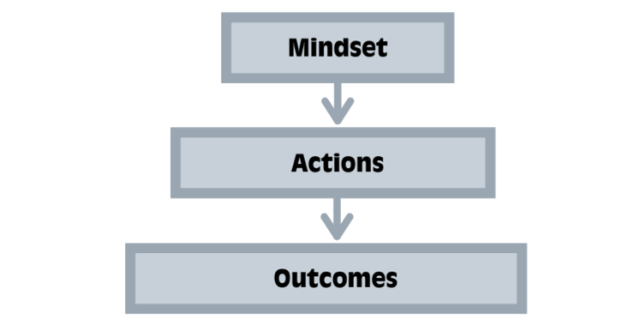Clinton on leadership
What is leadership? One of the most concise and yet comprehensive descriptions was given by former US president Bill Clinton, in a Fortune magazine interview in 2014.
“Leadership”, Clinton said, “means bringing people together in pursuit of a common cause, developing a plan to achieve it and staying with it until the goal is achieved.
Leadership also requires the ability to respond to unforeseen problems and opportunities when they arise.
Leaders need to be able to clearly articulate a vision of where they want to go, develop a realistic strategy to get there. They need to attract talented, committed people with a wide variety of knowledge, perspectives and skills. In the modern world, I believe lasting positive results are more likely to occur when leaders practice inclusion and cooperation rather than authoritarian unilateralism.”
Mindset
Leaders, like everybody else, achieve goals through their actions; what they do and what they say, how do you it and and how they say it. All these behaviours result from a certain way of thinking. Behind all those actions is a certain mindset. Somebody’s mindset includes how they feel, what mood they are in, their attitudes and beliefs and their thinking processes. A different mindset will results in different actions and different actions will result in different outcomes.

The Inner Game
Mindset is what sports coach W. Timothy Gallwey calls the Inner Game. Gallwey has pointed out that a sports person actually plays two games, or as he calls it: acts in two arenas of engagement. There is an inner arena and there is an outer arena. Gallwey started out developing its principle for the game of tennis and later expanded the application of his theory to cover professional excellence in all kinds of fields.
A tennis player has external goals like how to hold their racket, how to keep their breathing steady, how to focus on the ball, and so on. “The inner game”, Gallwey says, “takes place within the mind of the player and is played against such obstacles as fear, self-doubt, lapses of focus and limiting concepts and assumptions. The inner game is played to overcome the self-imposed obstacles that prevent the individual or a team from accessing their full potential.” The interaction between the inner game and the outer game is essential for both tennis players and leaders.

Any team and any leader will sooner or later run into obstacles. Markets changes, technologies appear, environments collapse. Say you are leading a photo press agency and ‘suddenly’ anyone with a smartphone can send their pictures to the paper. Or you direct a cab company and Uber appears.
When a leader combines an outer obstacle with a an inner obstacle of their own, problems tends to spiral out of hand. Take Volkswagen for example. They ran into a huge outer obstacle with their Audi A3, and VW models like Beetle and Passat. The engines in these cars (11 million world wide) emitted pollutants up to 40 times above what is allowed. Volkswagen leadership met this outer obstacle with inner obstacles like fear and a desire to hide. Rather than ‘practicing inclusion and cooperation’ as Bill Clinton would probably have advised them, they decided to illegally change the testing software to obtain ‘better results’. The rest is history: great damage to the Volkswagen brand and a slow, painful recovery. An outer obstacle was met with an inner obstacle.
So one essential quality of effective leaders is their ability to meet external obstacles with internal resources. This can turn a difficult challenge into an achievable goal. After the dust had settled a bit, Volkswagen leadership finally met the emission challenge with awareness, courage and vision. They are now envisioning Volkswagen as an electric car company and they have made a huge financial effort towards that goal. One wishes for Volkswagen that their leadership had met this outer obstacle white that inner resource 10 years earlier.
The leadership mindset as a resource
In this series of articles we will look at a set of inner resources for leaders: the Leadership Mindset. With the psychological tool MindSonar we can measure how people think and what they find important. In other words: MindSonar measures mindsets. What does the leadership mindset look like in terms of meta programs and Graves drives, the two types of human qualities MindSonar measures?
Leadership versus management
Leadership is closely related to motivating people. It is something entirely different from management. Management is often defined as ‘getting things done through others’. Leadership on the other hand, may be defined as ‘getting people to want to do things’. Management is usually associated with the improving productivity, establishing order and stability and making things run efficiently. Leadership is what sets the direction and keeps a group moving forward, even when there is a lot of uncertainty, upheaval and resistance.
The Four Elements
Taking Clinton’s definition as a starting point, we can distinguish four eseential elements in leadership:
- Vision
Clearly articulating and uplifting view of the future.
- Planning
Developing a realistic strategy.
- Engagement
Attracting talented and committed people.
- Resilience
Responding effectively to unforeseen problems.

We can distill three more aspects from the Clinton definition’. But we will set these aside for now:
- Tenacity
Staying with it until the goal is achieved.
- Flexibility
Being able to deal with and appreciate a wide variety of perspectives.
- Creativity
Making use of unforeseen opportunities.
These three do not seem as important as the first four. However, when later in this narrative we get to the fourth essential element, Resilience, we will see that it has a lot to do with tenacity, flexibility and creativity.
The next article in this series is about the vision element. We will look into the question what vision is, in a leadership frame, and how is shows up in a MindSonar profile.
About the author
Jaap Hollander
Psychologist, living in the Netherlands. Founded MindSonar in 1995. Directs MindSonar Global, which manages the ICT development, applications and the curriculum of the MS Certification Trainings. Working part time as a trainer, writer and coach as well as being an expressionist painter (artist name JAAPH, see jaaph.com). Has written 10 books on NLP and Provocative Coaching.

